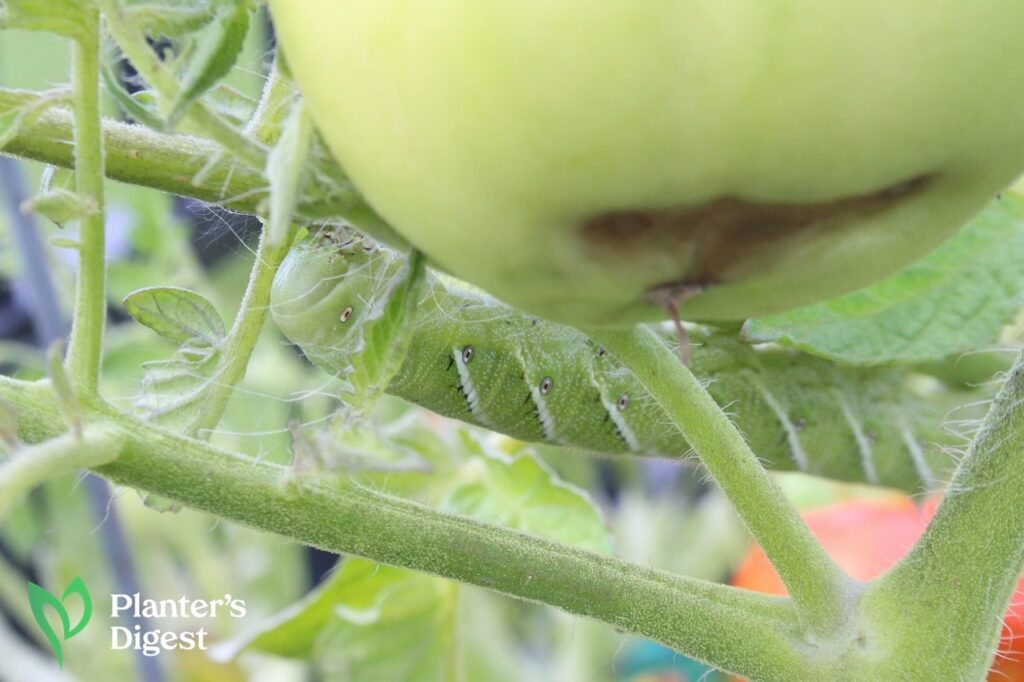
Most worms that eat tomato plants are actually caterpillars coming from armyworms, loopers and hornworms species. They might become beautiful butterflies soon, but that’s most likely at the expense of your tomato plant.
Fortunately, you’re on the right page, as we’ll help you identify the different types of worms that eat tomato plants and guide you on how to get rid of them. Read on to learn about them.
Common Worms That Eat Tomato Plants
1. Tomato Hornworm
| Scientific Name | Manduca quinquemaculata |
| Common Name | • Tomato Hornworm • Tomato Cutworm |
| How to Identify | • Green, brown, gray or yellow in color • White horizontal V-shaped stripes • Black horn at the back |
| What They Eat | • Leaves • Flower buds • Stems |
| What You Should Do | • Pick them off manually • Drop worms in soapy water |
Tomato hornworms have distinct chevron or white horizontal V-shaped stripes on their body and black horns at their backs. When you see black balls of frass on your leaves, check their undersides to track these worms.
They love feeding on the flesh of the leaves, leaving only their veins untouched. Their most damaging attack is on the stem of the tomato plant as they can cut down the plant.
These worms can feed on your whole tomato plant within 4 to 6 weeks. After the growing season, the worm will spend winter in the soil inside their cocoons and then begin laying eggs on the plant leaves, repeating the cycle.
| What You Should Do • Pick them off manually. Hand-pick the tomato hornworms and drop them in soapy water. Another alternative is to feed them to chickens. You can invest in a black light flashlight to easily spot these hornworms, especially when they attack your plant at night. • Apply organic pesticide. Organic pesticides with Bacillus thuringiensis are effective in killing tomato hornworms. It’s a stomach poison for these pests. |
2. Tobacco Hornworm
| Scientific Name | Manduca sexta |
| Common Name | • Tobacco Hornworm |
| How to Identify | • Diagonal stripes • Red horn at the back |
| What They Eat | • Leaves Green tomatoes |
| What You Should Do | • Pick them off manually • Drop worms in soapy water |
Tobacco hornworms, on the other hand, have diagonal stripes on their body and red horns at the back.
They come from the larvae of the tobacco hawk moth, which is also known as the Carolina sphinx moth. This moth lays eggs on the plant leaves, which will alter the hatch and develop into tobacco hornworms.
Tobacco hornworms also strip the plant of its leaves. It even damages the skin of green tomatoes, making them more vulnerable to other pests and plant diseases.
| What You Should Do • Pick them off manually. Hand-pick the tobacco hornworms and drop them in soapy water. Another alternative is to feed them to chickens. You can invest in a black light flashlight to easily spot these hornworms, especially when they attack your plant at night. • Apply organic pesticide. Organic pesticides with Bacillus thuringiensis are effective in killing tomato hornworms. It’s a stomach poison for these pests. |
3. Beet Armyworm
| Scientific Name | Spodoptera exigua |
| Common Name | • Beet Armyworm • Small Mottled Willow Moth |
| How to Identify | • Pale green or yellow in color • Striped body • Dark dashes along the sides • Leaves strands of silk |
| What They Eat | • Flower buds • Leaves • Fruits |
| What You Should Do | • Use pheromone traps • Pick them off by hand • Apply Neem oil |
Beet armyworms are usually pale green or yellow with stripes and dark dashes along their bodies. You’ll know you have them when you see your leaves with strands of silk.
This caterpillar comes from the Small Mottled Willow Moth, which lays eggs on the leaves of the tomato plant. They usually attack the plant later in the growing season, but when they do, say goodbye to your leaves, fruits and flower buds.
| What You Should Do • Use pheromone traps. Bait the worms with insecticides like cypermethrin or a quick knock-down agent to attract and kill moths. • Pick them off manually. Hand-pick the tomato hornworms and drop them in soapy water. Another alternative is to feed them to chickens. You can invest in a black light flashlight to easily spot these worms as they attack your plant at night. • Apply Neem oil. Apply Neem oil on your tomato plant to make its taste unappealing to the worms and cause them to look for other hosts. |
4. Fall Armyworm
| Scientific Name | Spodoptera frugiperda |
| Common Name | • Fall Armyworm |
| How to Identify | • Brown, green or yellow with stripes • Inverted V on the head • Males have white spots on their wings |
| What They Eat | • Fruit |
| What You Should Do | • Use pheromone traps • Apply organic pesticide |
Fall armyworms are usually brown, green or yellow with stripes with an inverted V imprinted on their heads. These caterpillars are active from the end of summer until fall.
You can identify male fall armyworms through their white spots on each wing, while their female counterparts typically lay eggs on the undersides of leaves.
A female armyworm can lay over 2,000 eggs at once. Once the larvae appear, they begin feeding on the fruits, causing them to rot and fall on the ground.
| What You Should Do • Use pheromone traps. Bait the worms with insecticides like cypermethrin or a quick knock-down agent to attract and kill moths. • Apply organic pesticide. Organic pesticides with Bacillus thuringiensis are effective in worms by poisoning their stomachs. |
5. Yellow-striped Armyworm
| Scientific Name | Spodoptera ornithogalli |
| Common Name | • Yellow-striped Armyworm • Owlet Moths |
| How to Identify | • Yellow stripes along the sides • Dark spot at the back • Inverted V on the head |
| What They Eat | • Leaves • Fruits |
| What You Should Do | • Use organic pesticides |
The yellow-striped armyworm has yellow stripes along its sides, a dark spot on its back and an inverted V on its head. It’s a nocturnal tomato pest feeding on the plant at night.
This moth can lay between 200 to 500 eggs at a time, and each will hatch within 3 to 5 days.
Because of their fast reproduction, the yellow-striped armyworm can kill not only a plant but the whole tomato crop in your garden in a short amount of time. They feed on the leaves and damage the tomato fruits right away.
| What You Should Do • Apply organic pesticide. Organic pesticides with Bacillus thuringiensis are effective in killing yellow-striped armyworms. It’s stomach poison for these caterpillars and can destroy them from the inside out. |
6. Tomato Loopers
| Scientific Name | Chrysodeixis chalcites |
| Common Name | • Tomato looper • Golden twin-spot moth • Cabbage looper |
| How to Identify | • Green or brown-gold with two droplet-shaped white marks on the forewing |
| What They Eat | • Leaves Fruits |
| What You Should Do | • Remove them by hand • Apply insecticides |
Tomato loopers are easily identifiable when they arch their back into a loop as it crawls, hence its name.
This caterpillar typically lays its eggs on the undersides of the upper large leaves of the tomato plant. Unfortunately, one moth can lay thousands of eggs in a day.
Tomato loopers are also called cabbage loopers since they are also common pests to other vegetables like cabbage, broccoli, beans, spinach, lettuce and celery.
| What You Should Do • Remove them by hand. Hand-pick the tomato loopers and drop them into soapy water to kill them. • Apply insecticide specifically made for tomato loopers. |
7. Tomato Fruitworm
| Scientific Name | Helicoverpa zea |
| Common Name | • Tomato Fruitworm • Bollworms • Corn earworm |
| How to Identify | • Brown, cream, black, grey or yellow with stripes on the sides • Hairy body |
| What They Eat | • Fruits • Stems • Leaves |
| What You Should Do | • Remove damaged fruits, leaves and stems • Apply Bacillus thuringiensis or diatomaceous earth • Use parasitic wasps |
Tomato fruit worms come in brown, cream, black, grey or yellow colors with white stripes bordering their hairy sides.
They attack the tomato plant at night, feeding on its stems and leaves and burrowing holes in its fruits.
As their name suggests, tomato fruit worms love ripe tomatoes. They burrow holes in them or leave blemishes on their skin, but you’ll see them feasting on the fruit inside once opened.
| What You Should Do • Remove damaged fruits, leaves and stems. Prune any damaged fruits, leaves and stems to stop tomato fruit worm infestation. • Apply Bacillus thuringiensis or diatomaceous earth. Organic pesticides with Bacillus thuringiensis will poison the worms’ stomachs, while diatomaceous earth will cut them open upon contact. • Use parasitic wasps. By laying eggs on the back of tomato fruit worms, wasps can feed on the worms inside out. |
8. Tomato Moth Caterpillar
| Scientific Name | Lacanobia oleracea |
| Common Name | • Tomato Moth Caterpillar • Bright-line Brown-eye |
| How to Identify | • Changes from pale green to mottled grey to brown in color • Yellow stripes with black spots on the sides |
| What They Eat | • Leaves • Fruits |
| What You Should Do | • Pick them off by hand • Apply insecticide |
Tomato moth caterpillars grow into different colors in every stage of their lives – from pale green to mottled grey to brown. You’ll see yellow stripes with black spots on their sides as they mature.
They’re commonly found in tomato plants in greenhouses and are most active during summer and at night. They lay as many as 300 eggs on the undersides of tomato leaves which hatch into caterpillars within seven days.
Tomato moths begin by eating the leaves of the plant. Later on, it will burrow holes in each fruit.
| What You Should Do • Pick them off by hand. Hand-pick the tomato moths and drop them into soapy water to kill them. • Apply insecticide specifically made for tomato moths. |
Tips on How to Prevent Worms That Eat Tomatoes
Fortunately, many ways exist to prevent worms from infesting your tomato plants in the first place. Here are our top tips on how to keep them away.
1. Sprinkle diatomaceous earth on your tomato plant.
Diatomaceous earth is a common gardening tool for dealing with pests like worms and bugs. It’s a white powder that’s sharp enough to pierce through the bodies of worms and insects when they crawl or come in contact with it.
As a result, these worms will die of dehydration or because of the injuries caused by the sharp diatomaceous earth.
However, this powder may also hurt pollinators like bees, so you should practice hand pollination to ensure your flowers are still fertilized.
When applying this on your tomato plant, make sure to wear a mask to prevent irritation of your lungs.
2. Spray Neem oil on your tomato plants.
Neem oil is another garden pest killer and repellant. Because of its harsh odor, it kills aphids, snails, flies, worms and caterpillars.
When spraying them on your tomato plants, the taste of the plant is unappealing to pests, causing them to leave and look for other plants to pester.
To keep you safe, make sure to wear a mask and wash the neem oil off your hands to avoid spreading it to other plants in your garden.
3. Put ladybugs and wasps.
Ladybugs and wasps can be your go-to insects in protecting your tomato plant.
Ladybugs, for instance, help eat the eggs and tiny larvae on the undersides of the tomato leaves.
On the other hand, wasps parasitize these worms and caterpillars by laying eggs on their backs.
Braconid wasps, for instance, are parasites for hornworms. They lay eggs on the back of these worms, and once they hatch, they feed on the hornworm inside out.
4. Attract birds.
We all know birds love eating worms, so why not create a hospitable environment to attract them in your backyard?
Try placing a birdbath where they can drink water or a birdhouse with seeds they can also feed on.
As they feel at home in your garden, in no time, they’ll also be helping you get rid of these worms by eating them.
5. Till the soil.
Most moth species hibernate during winter in the soil, mulch or compost. So, it’s recommended to till your soil before planting to disturb its life cycle.
Just keep out of the way of earthworms because they are the beneficial type of worms that help improve the soil structure and break down organic matter for your plants.
6. Practice crop rotation.
Crop rotation means planting different crops in the same plot of land every 2, 3 or 4 years. This way, you can prevent the same worms from other plants in your garden.
This gardening hack is especially effective for nightshade plants that get infested by the same type of worms as the tomato hornworms.
For instance, you can plant green beans, peas, peanuts or clovers on a former tomato plot during the interval year. They will not only prevent infestation but also help restore nitrogen in the soil.
7. Practice companion planting.
Placing companion plants with your tomatoes is also effective in repelling pests and insects. You can add plants like dill, parsley, garlic, chives, nasturtiums and marigolds to your tomato plant.
For instance, fragrant herbs like thyme and basil are effective in deterring yellow-striped armyworms from laying eggs.
FAQs
Tomato fruit worms are the culprit of holes in tomato fruits. They burrow into the fruit, which becomes a breeding ground for fungi causing the fruit to rot later on.
You can no longer eat tomatoes damaged by worms. These worms usually burrow into the fruit and leave the space with water, decay and rot, rendering it unsuitable for consumption.
The most common types of worms that eat tomato plants are caterpillars such as hornworms, armyworms, fruit worms and loopers.
Moth larva causes tomato worms. These moths lay eggs on the undersides of tomato leaves which hatch into caterpillars and feed on parts of the whole tomato plant.




